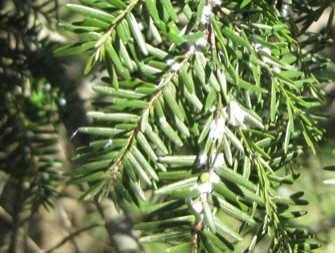Hemlock Woolly Adelgid (HWA)

Hemlock Woolly Adelgid (HWA), Adelgis tsugae, a destructive aphid-like insect pest of eastern and Carolina hemlock, is originally from Asia.
HWA feeds on trees of all ages. The insects attach themselves to the base of the hemlock needles and feed from the new twig growth with piercing-sucking mouthparts. The most noticeable aspect of infested hemlocks is the white masses at the base of needles on the twigs. The adults are small (1/32 inch), oval and reddish purple, although covered with white, waxy tufts.
Limb dieback may occur within two years of the initial infestation on seedlings and saplings. Heavily infested larger trees usually die within four years, although it may take longer than 10 years depending on proximity to other infested trees, tree size, the level of environmental stress and the quality of the growing site.
HWA is established in East Tennessee. In April 2017, HWA was found in Overton County. In March 2017, HWA was found in Warren County. There are now 43 counties in Tennessee that have infestations. The six US states with HWA quarantines are Maine, Michigan, New Hampshire, Ohio, Vermont and Wisconsin. Canada also has a HWA quarantine in effect.
The entry requirements for Hemlocks from infested or adjacent areas vary from state to state. A State Phytosanitary Certificate is required. State summaries may be found at the National Plant Board (NPB) laws and summaries site https://www.nationalplantboard.org/state-law--regulation-summaries.html. For example, Michigan's quarantine does not allow movement of hemlock from an infested or adjacent county into the state. For more information, contact the State Plant Regulatory Official in the state you're intending to move hemlock (contact information at NPB site) or contact the Tennessee Department of Agriculture (Anni Self or Steve Powell) at 615-837-5137.